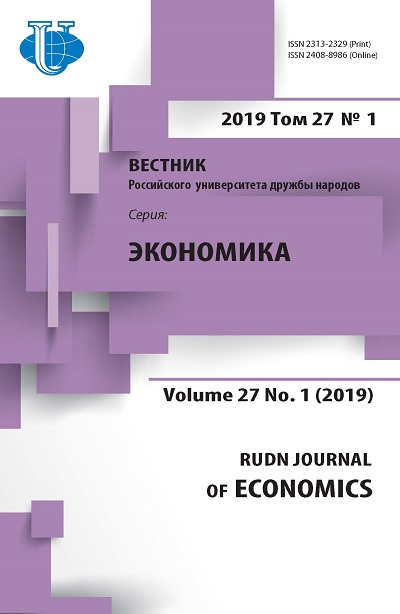The human capital rationale behind the economic growth of the European Union countries: application of the advanced methods to enhance an efficiency of national human capital stocks
- Authors: Stabinskaite I.A.1
-
Affiliations:
- State University of Management
- Issue: Vol 27, No 1 (2019)
- Pages: 35-48
- Section: ECONOMIC GROWTH AND SOCIO-ECONOMIC DEVELOPMENT
- URL: https://journals.rudn.ru/economics/article/view/21299
- DOI: https://doi.org/10.22363/2313-2329-2019-27-1-35-48
Cite item
Full Text
Abstract
Human capital is an important factor of economic growth, as has been underlined by recent theoretical models. The main goal of this article is to elucidate the relationship between human capital and dynamics of economic growth in the European Union (EU). For the purposes of this article human capital is defined as knowledge, skills as well as other individual factors which lead to higher productivity. Therefore, the greatest attention is focused on the multi-dimensional assessment of human capital in the processes of economic development of the European countries. A detailed evaluation of human capital in the EU is represented at interregional and international levels. Furthermore, author suggests a guidance for designing and planning strategies aimed at sustainable economic development by using the model predictive control algorithms.
Keywords
About the authors
Iuliia A. Stabinskaite
State University of Management
Author for correspondence.
Email: stabinskayte@gmail.com
Ph.D. student of the Department of Economic Theory and World Economy, State University of Management
99 Ryazanskiy Ave., Moscow, 109542, Russian FederationReferences
- Aghion P., Meghir C. (2004). Growth, distance to frontier and consumption of human capital. The Institure for Fiscal Studies, WP04/31, 1-50. https://pdfs.semanticscholar.org/53b3/afe03f5248a c03e415a136a6884c0de8e14f.pdf?_ga=2.172718883.109754537.15409762321101141696.1540976232 (accessed: 20.10.2018).
- Benhabib J., Spiegel M.M. (1994). The role of human capital in economic development: evidence from aggregate cross-country data. Journal of monetary economics, (34), 143-173.
- Ciccone A., Papaioannou E. (2009). Human capital, the structure of production and growth. The review of economics and statistics, (1), 66-82.
- Goldin C. (2016). Human Capital: Handbook of Cliometrics. Springer: Verlag Berlin Heidelberg, 86. doi: 10.1007/978-3-642-40406-1_23
- Jones C. (2002). Sourses of U.S. economic growth in a world of ideas. American economic review, 92(1), 220-239.
- Korotaev A.V., Malkov S.U., Akaev A.A. (2013). Mirovaya dinamika. Zakonomernosti, tendentsii, perspectivi [World Dynamics: Patterns, tendencies, perspectives]. Мoscow: URSS Publ., 488. (In Russ.)
- Lucas R. (1988). On the mechanics of economic development. Journal of monetary economics, 22(1), 3-42.
- Lukyanov S.A. (2008). Otsenka znachimosti otraslevih vhodnih bar’erov kak instrumenta ogranicheniya konkurentsii [Assessment of the importance of sectoral entry barriers as an instrument of competitiveness restriction]. Problemi sovremennoy economiki, 3(27), 194-198. (In Russ.)
- Lukyanov S.A., Avramenko E.S., Vlasov S.V., Temkina I.M. (2015). Investitsionnaya politika regiona v usloviyah budgetnih ogranicheniy i economicheskih sankciy [Investment policy of a region in the conditions of the budgetary restrictions and economic sanctions]. Economika regiona, 1(41), 213-223. doi: 10.17059/2015-1-18. (In Russ.)
- Lukyanov S.A., Drapkin I.M. (2017). Globalnie tsepochki sozdaniya stoimosti: effecti dlya integriguyusheysya economiki [Global value chains: effects for integrating economy]. Mirovaya economika i mezhdunarodnie otnosheniya, 61(4),. 16-25. doi: 10.20542/0131-2227-2017-61-416-25. (In Russ.)
- Mankiw G., Romer D., Weil D. (1992). A contribution to the empirics of economic growth. Quarterly journal of economy, 107(2), 407-437.
- Nelson R.R., Phelps S.E. (1966). Investment in humans, technological diffusion, and economic growth. American economic review, (56), 69-75.
- Park J. (2006). Dispersion of human capital and economic growth. Journal of macroeconomics, 28(3), 520-539.
- Ponomarev A.A. (2014). Postroenie suboptimal’nogo upravleniya v regulyatore “predictor-corrector” [Suboptimal control construction for the model predictive controller]. Vestnik SPBGU. Seriya 10, 3. doi: 10.21638/11701/spbu10.2017.206. (In Russ.)
- Ruzhanskaya L.S., Lukyanov S.A., Alaev G.A. (2018). Country Effects On Managerial Practices in Transportation Area: Evidence From Russia and Germany. Economy of Region, 14(2), 530-535. doi: 10.17059/2018-2-15.
- Sadovnichiy V.A., Akaev A.A., Korotaev A.V. (2016). Kachestvo obrazovaniya, effectivnost’ NIOKR i economicheskiy rost: kolichestveniy analiz i matematicheskoe modelirovanie [Quality of education, R&D effectiveness and economic growth: quantitative analysis and mathematical modelling]. Мoscow: LENAND Publ., 352. (In Russ.)















